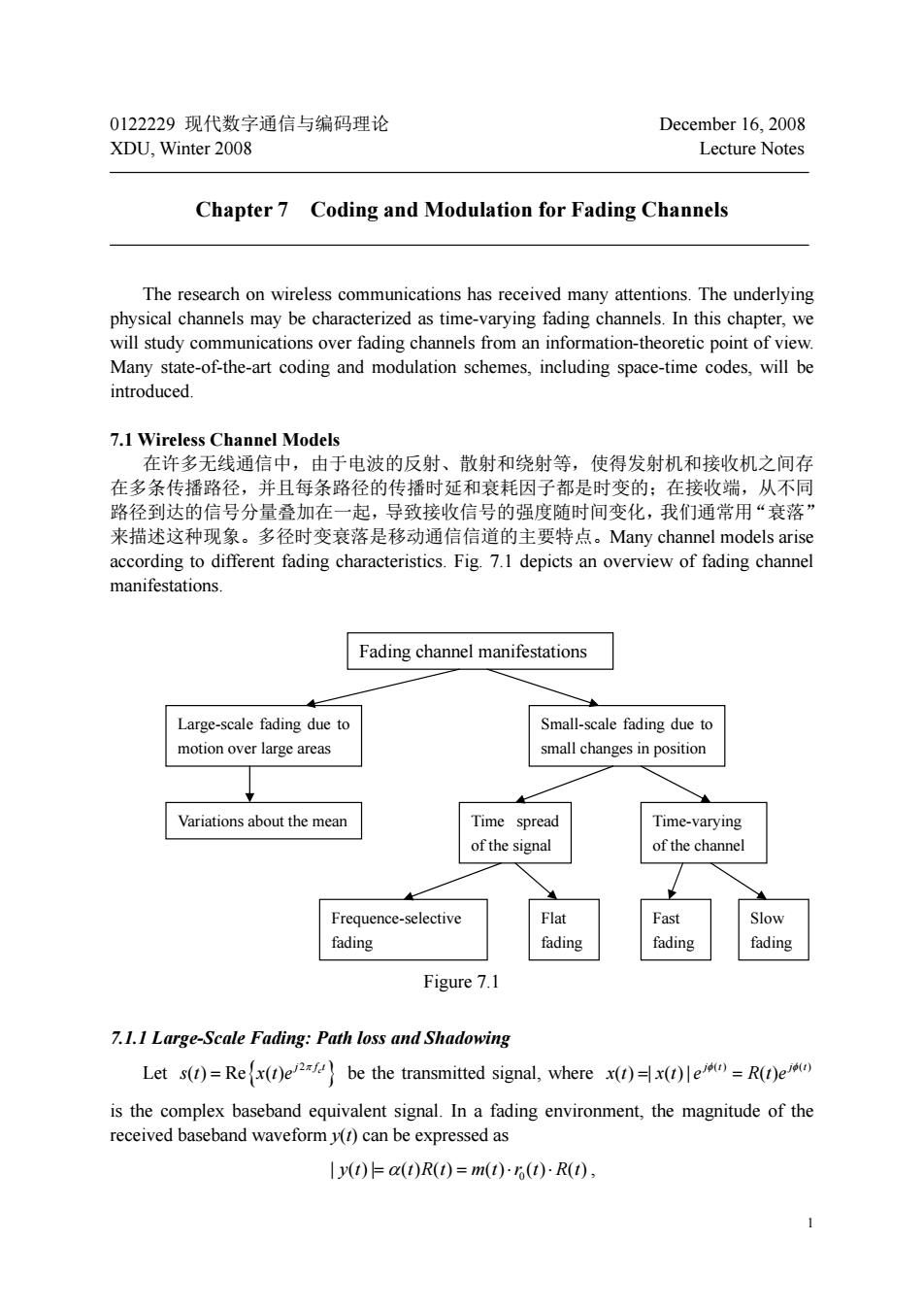
0122229现代数字通信与编码理论 December 16,2008 XDU,Winter 2008 Lecture Notes Chapter 7 Coding and Modulation for Fading Channels physical channels may be characterized as time-varying fading channels.In this chapter,we will study communications over fading channels from an information-theoretic point of view. Many state-of-the-art coding and modulation schemes,including space-time codes,will be introduced. 7.1 Wireless Cha nne 1 Models 无线通信中,由于电波的反射、散射和绕射等,使得发射机和接收机之间有 在多条传播路径,并且每条路径的传播时延和衰耗因子都是时变的:在接收端,从不同 路径到达的信号分量叠加在一起,导致接收信号的强度随时间变化,我们通常用“衰落” 来描述这种现象。多径时变衰落是移动通信信道的主要特点。Many channel models arise or fading.Fi7.I depicts an overview of fading manifestations Fading channel manifestations Large-scale fading due to Small-scale fading due to motion over large areas small changes in position Variations about the mean Time spread Time-varying of the signal of the channel Frequence-selective fading ading ading Figure 7.1 7.1.1 Large-Scale Fading:Path loss and Shadowing Let s()=Rex()e be the transmitted signal,where x(t)x()e=R(e) is the complex baseband equivalent signal.In a fading environment,the magnitude of the received baseband waveform()can be expressed as |()Fa()R0=m)-()R()
1 0122229 现代数字通信与编码理论 December 16, 2008 XDU, Winter 2008 Lecture Notes Chapter 7 Coding and Modulation for Fading Channels The research on wireless communications has received many attentions. The underlying physical channels may be characterized as time-varying fading channels. In this chapter, we will study communications over fading channels from an information-theoretic point of view. Many state-of-the-art coding and modulation schemes, including space-time codes, will be introduced. 7.1 Wireless Channel Models 在许多无线通信中,由于电波的反射、散射和绕射等,使得发射机和接收机之间存 在多条传播路径,并且每条路径的传播时延和衰耗因子都是时变的;在接收端,从不同 路径到达的信号分量叠加在一起,导致接收信号的强度随时间变化,我们通常用“衰落” 来描述这种现象。多径时变衰落是移动通信信道的主要特点。Many channel models arise according to different fading characteristics. Fig. 7.1 depicts an overview of fading channel manifestations. Figure 7.1 7.1.1 Large-Scale Fading: Path loss and Shadowing Let 2 ( ) Re ( ) c j ft st xte be the transmitted signal, where () () ( ) | ( )| ( ) jt jt x t xt e Rte is the complex baseband equivalent signal. In a fading environment, the magnitude of the received baseband waveform y(t) can be expressed as 0 | ( )| ( ) ( ) ( ) ( ) ( ) y t tRt mt r t Rt , Fading channel manifestations Large-scale fading due to motion over large areas Small-scale fading due to small changes in position Variations about the mean Time spread of the signal Time-varying of the channel Frequence-selective fading Flat fading Fast fading Slow fading
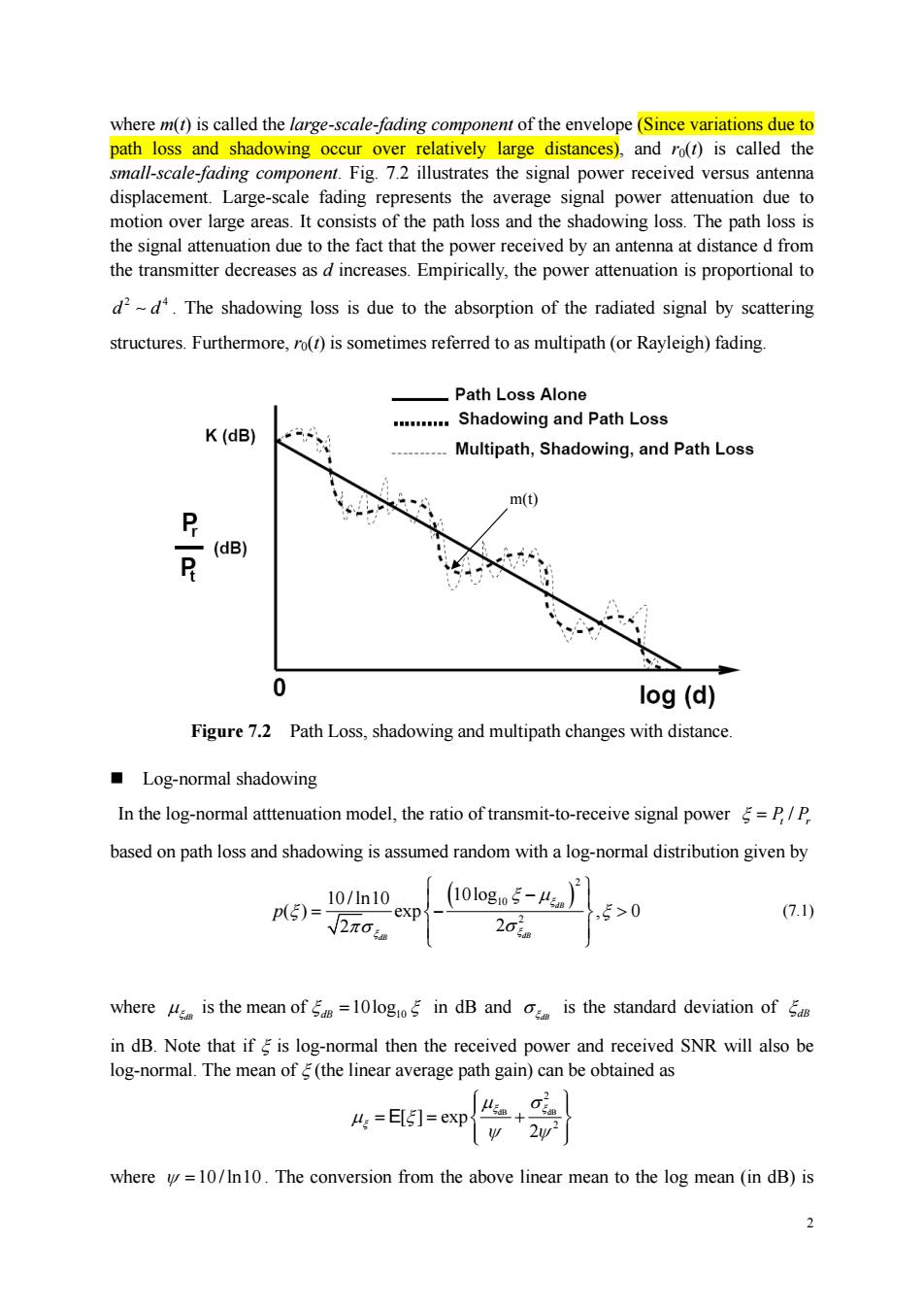
where m(t)is called the large-scale-fading component of the envelope(Since variations due to path loss and shadowing oc arge distances) and ro(t)is called the mall-scale-fadi ng component.Fig 72 illustrates the signal power received versus antenna displacement.Large-scale fading represents the average signal power attenuation due to motion over large areas.It consists of the path loss and the shadowing loss.The path loss is the signal attenuation due to the fact that the power received by an antenna at distance d from the transmitter decreases as d increases.Empirically,the power attenuation is proportional to d2-d.The shadowing loss is due to the absorption of the radiated signal by scattering structures.Furthermore,ro(r)is sometimes referred to as multipath(or Rayleigh)fading. Path Loss Alone .Shadowing and Path Loss K(dB) Multipath,Shadowing,and Path Loss m(0 公 (dB) 0 log (d) Figure 7.2 Path Loss,shadowing and multipath changes with distance. Log-normal shadowing In the log-normal atttenuation model,the ratio of transmit-to-receive signal power=P/P based on path loss and shadowing is assumed random with a log-normal distribution given by Pp(53=10/1n10 XD _(10g5-4l ,5>0 (7.1) where is the mean of=10log in dB and is the standard deviation of in dB.Note that if is log-normal then the received power and received SNR will also be log-normal.The mean of(the linear average path gain)can be btain where =10/In10.The conversion from the above linear mean to the log mean (in dB)is
2 where m(t) is called the large-scale-fading component of the envelope (Since variations due to path loss and shadowing occur over relatively large distances), and r0(t) is called the small-scale-fading component. Fig. 7.2 illustrates the signal power received versus antenna displacement. Large-scale fading represents the average signal power attenuation due to motion over large areas. It consists of the path loss and the shadowing loss. The path loss is the signal attenuation due to the fact that the power received by an antenna at distance d from the transmitter decreases as d increases. Empirically, the power attenuation is proportional to 2 4 d d . The shadowing loss is due to the absorption of the radiated signal by scattering structures. Furthermore, r0(t) is sometimes referred to as multipath (or Rayleigh) fading. Figure 7.2 Path Loss, shadowing and multipath changes with distance. Log-normal shadowing In the log-normal atttenuation model, the ratio of transmit-to-receive signal power / P P t r based on path loss and shadowing is assumed random with a log-normal distribution given by 2 10 2 10 / ln10 10log ( ) exp , 0 2 2 dB dB dB p (7.1) where 10 is the mean of 10log dB dB in dB and dB is the standard deviation of dB in dB. Note that if is log-normal then the received power and received SNR will also be log-normal. The mean of (the linear average path gain) can be obtained as dB dB 2 2 [ ] exp 2 E where 10 / ln10 . The conversion from the above linear mean to the log mean (in dB) is m(t)
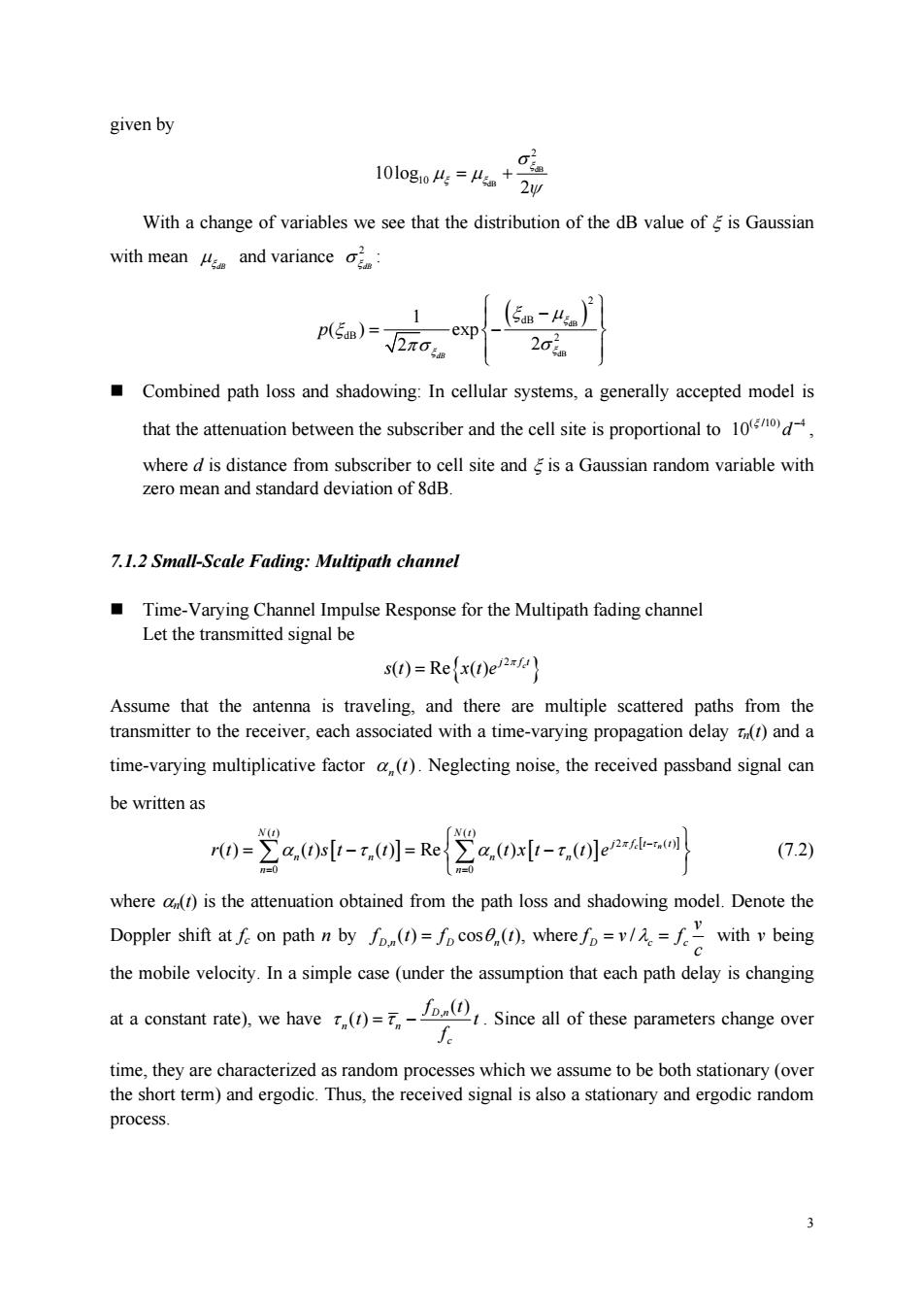
given by 0a从-儿+ With a change of variables we see that the distribution of the dB value of is Gaussian with mean and variance 1 pl5=2π0 -exp (5-4 Combined path loss and shadowing:In cellular systems,a generally accepted model is that the attenuation between the subscriber and the cell site is proportional to1 where d is distance from subscriber to cell site andis a Gaussian random variable with zero mean and standard deviation of 8dB. 7.1.2 Small-Scale Fading:Multipath channel Time-Varying Channel Impulse Response for the Multipath fading channel Let the transmitted signal be s(t)=Re(x(t)e Assume that the antenna is traveling.and there are multiple scattered paths from the transmitter to the receiver,each associated with a time-varying propagation delay()and a time-varying multiplicative factor (t).Neglecting noise,the received passband signal can be written as =。 ()st-r.(]-Re(-r.( (7.2) where)is the attenuation obtained from the path loss and shadowing model.Denote the Doppler shift at fe on path n by o ()=fcos,(t),where==with y being the mobile velocity.In a simple case(under the assumption that each path delay is changing ataconstant rate),we have(Since all of these parameters change over time,theyare characterized asrandom proces sses which we assume to be both stationary (ove the short term)and ergodic.Thus,the received signal is also a stationary and ergodic random process
3 given by dB dB 2 10 10log 2 With a change of variables we see that the distribution of the dB value of is Gaussian with mean dB and variance 2 dB : dB dB 2 dB dB 2 1 ( ) exp 2 2 dB p Combined path loss and shadowing: In cellular systems, a generally accepted model is that the attenuation between the subscriber and the cell site is proportional to ( /10) 4 10 d , where d is distance from subscriber to cell site and is a Gaussian random variable with zero mean and standard deviation of 8dB. 7.1.2 Small-Scale Fading: Multipath channel Time-Varying Channel Impulse Response for the Multipath fading channel Let the transmitted signal be 2 ( ) Re ( ) c j ft st xte Assume that the antenna is traveling, and there are multiple scattered paths from the transmitter to the receiver, each associated with a time-varying propagation delay n(t) and a time-varying multiplicative factor ( ) n t . Neglecting noise, the received passband signal can be written as () () 2 () 0 0 ( ) ( ) ( ) Re ( ) ( ) c n Nt Nt j ft t nn n n n n rt tst t txt t e (7.2) where n(t) is the attenuation obtained from the path loss and shadowing model. Denote the Doppler shift at fc on path n by , ( ) cos ( ), where / Dn D n D c c v f tf t fv f c with v being the mobile velocity. In a simple case (under the assumption that each path delay is changing at a constant rate), we have , ( ) ( ) D n n n c f t t t f . Since all of these parameters change over time, they are characterized as random processes which we assume to be both stationary (over the short term) and ergodic. Thus, the received signal is also a stationary and ergodic random process
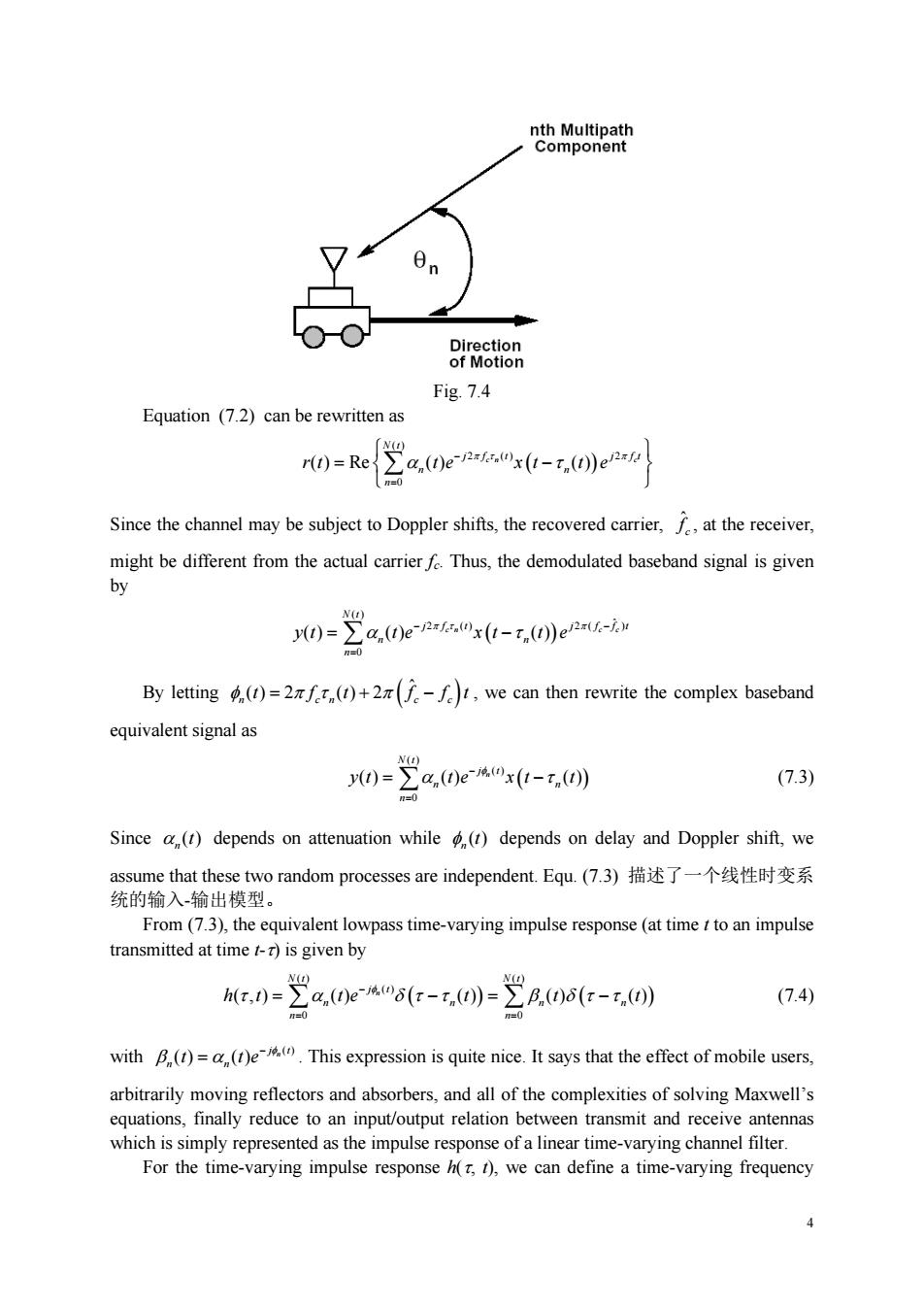
ncoMpgoHeat Fig.7.4 Equation(7.2)can be rewritten as ro-Rea.0-. Since the channel may be subject to Doppler shifts,the recovered carrier,f at the receiver, might be different from the actual carrier Thus,the demodulated baseband signal is given by 0=∑a.0e2.ox-r.0)e2-d By letting()=()+,we can then rewrite the complex baseband equivalent signal as 0-2a0et-0叭 (7.3) Since a()depends on attenuation while()depends on delay and Doppler shift,we assume that these two random processes are independent.Equ.(7.3)描述了一个线性时变系 统的输入输出模型。 From(7.3),the equivalent lowpass time-varying impulse response(at timeto an impulse hc0-2a0ewar-0)-2A06(r-r0) (7.4) with B()(e This expression is quite nice.It says that the effect of mobile users. arbitrarily moving reflectors and absorbers,and all of the complexities of solving Maxwell's equations,finally reduce to an input/output relation between transmit and receive antennas which is simply represented as the impulse response of a linear time-varying channel filter. For the time-varying impulse responseh(),we can define a time-varying frequency
4 Fig. 7.4 Equation (7.2) can be rewritten as ( ) 2 () 2 0 ( ) Re ( ) ( ) cn c N t j f t j ft n n n rt te x t t e Since the channel may be subject to Doppler shifts, the recovered carrier, ˆ c f , at the receiver, might be different from the actual carrier fc. Thus, the demodulated baseband signal is given by ( ) ˆ 2 () 2 ( ) 0 () () () cn c c N t j f t j f ft n n n yt te xt t e By letting ˆ () 2 () 2 n cn c c t f t f ft , we can then rewrite the complex baseband equivalent signal as ( ) ( ) 0 () () () n N t j t n n n y t te xt t (7.3) Since ( ) n t depends on attenuation while ( ) n t depends on delay and Doppler shift, we assume that these two random processes are independent. Equ. (7.3) 描述了一个线性时变系 统的输入-输出模型。 From (7.3), the equivalent lowpass time-varying impulse response (at time t to an impulse transmitted at time t-) is given by () () ( ) 0 0 ( ,) () () () () n Nt Nt j t n n nn n n h t te t t t (7.4) with ( ) () () n j t n n t te . This expression is quite nice. It says that the effect of mobile users, arbitrarily moving reflectors and absorbers, and all of the complexities of solving Maxwell’s equations, finally reduce to an input/output relation between transmit and receive antennas which is simply represented as the impulse response of a linear time-varying channel filter. For the time-varying impulse response h(, t), we can define a time-varying frequency

response Hf:()=[hr.D)esdrB.(e One way of interpreting H(f.t)is to think of the system as a slowly varying function of t with a frequency response H(f r)at each fixed time t.Corresponding,h()can be thought of as the impulse response of the system at a fixed time t.This is a legitimate and useful way of thinking about multipath fading channels. as the time-scale at which the channel varies is typically much longer than the delay spread of the impulse response at a fixed time 7.1.3 Time and Frequency Coherence Wireless channels change both in time and frequency.The time coherence shows us how quickly the channel changes in time,and similarly,the frequency coherence shows how quickly it changes in frequency 7.1.3.I Delay spread and Coherence bandwidth Multipath delay spread The multipath delay spread of a channel h()is given by T.=max t,()-mint,() (7.5) For a single transmitted impulse,it represents the maximum excess delay,after which the multipath signal power falls below some threshold level relative to the strongest component. The minimum delay min()is often set to zero and the other multipath delays normalized root-mean-squared(rms)delay spread,defined as ,=F-可 where is the mean excess delay Multipath Intensity Profile The multipath intensity profile.also called the power delay profile,is defined as the autocorrelation E[h(,)h'(,)]=R()1-t)兰R(r) where=.It represents the average power associated with a given multipath delay. We can also characterize the time-varying multipath channel in the frequency domain. The autocorrelation of(is given by EH(f,)H'(f,t+△)]=R,(Af,△) where f=f-f.If we define R(Af)R(f.0),then it can be shown that
5 response ( ) 2 2 () 0 ( ;) ( ,) () n N t j f jft n n H f t h te d te One way of interpreting H(f; t) is to think of the system as a slowly varying function of t with a frequency response H(f; t) at each fixed time t. Corresponding, h(, t) can be thought of as the impulse response of the system at a fixed time t. This is a legitimate and useful way of thinking about multipath fading channels, as the time-scale at which the channel varies is typically much longer than the delay spread of the impulse response at a fixed time. 7.1.3 Time and Frequency Coherence Wireless channels change both in time and frequency. The time coherence shows us how quickly the channel changes in time, and similarly, the frequency coherence shows how quickly it changes in frequency. 7.1.3.1 Delay spread and Coherence bandwidth Multipath delay spread The multipath delay spread of a channel h(, t) is given by max ( ) min ( ) mn n n n T tt (7.5) For a single transmitted impulse, it represents the maximum excess delay, after which the multipath signal power falls below some threshold level relative to the strongest component. The minimum delay min ( ) n n t is often set to zero and the other multipath delays normalized with respect to this minimum delay. Another often used parameter to characterize the delay spread of the channel is the root-mean-squared (rms) delay spread, defined as 2 2 ( ) where is the mean excess delay. Multipath Intensity Profile The multipath intensity profile, also called the power delay profile, is defined as the autocorrelation * 1 2 1 12 ( ,) ( ,) ( ) ( ) () E h th t R R h h where 1 2 . It represents the average power associated with a given multipath delay. We can also characterize the time-varying multipath channel in the frequency domain. The autocorrelation of () is given by * 1 2 ( ,) ( , ) ( , ) E H f tH f t t R f t H where 2 1 f f f . If we define ( ) ( ,0) RH H fRf , then it can be shown that
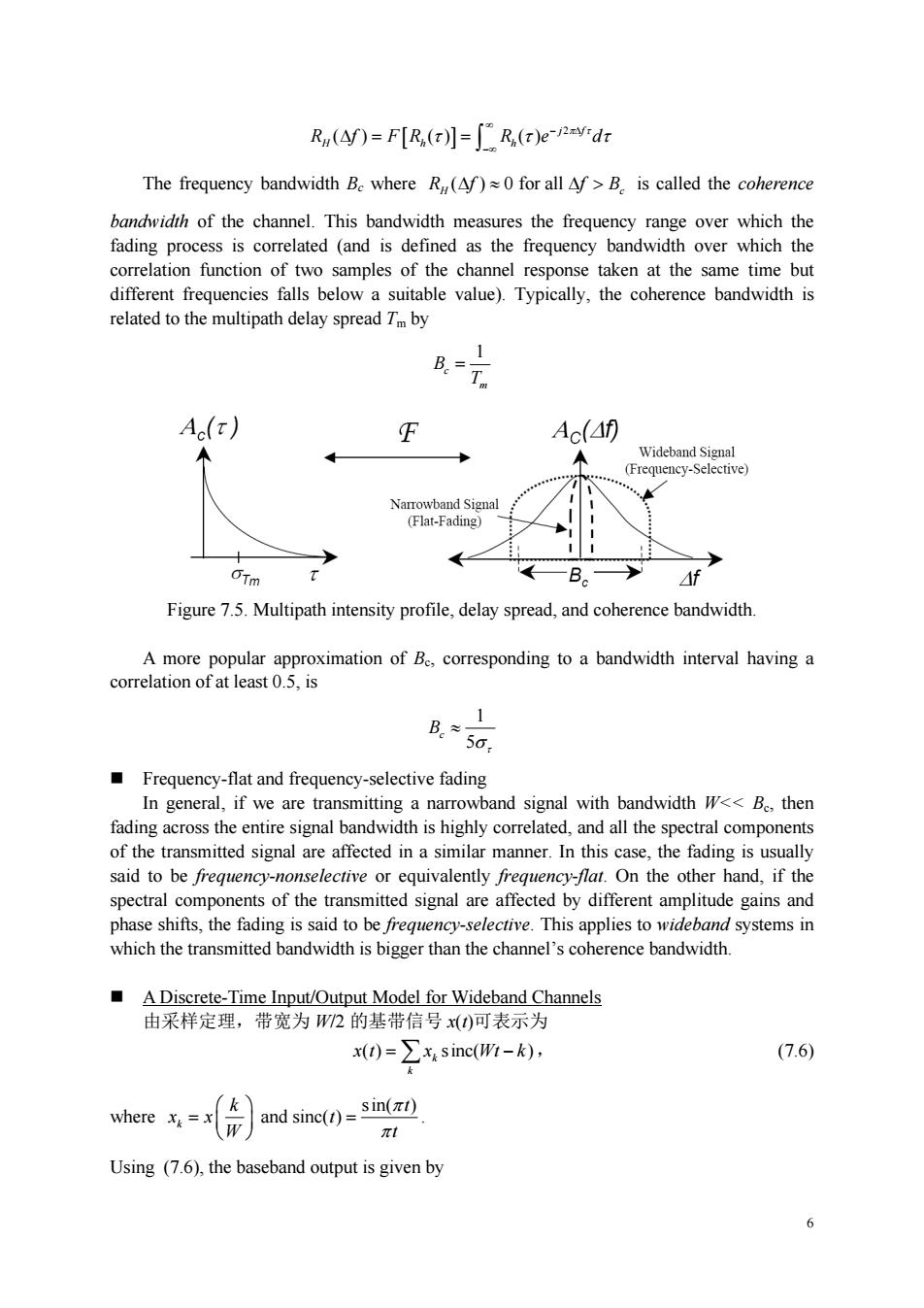
R(f)=F[R,()]=[R(r)e-vidr The frequency bandwidth B.where R(f)0 for all f>B.is called the coherence bandwidth of the channel.This bandwidth measures the frequency range over which the fading process is correlated (and is defined as the frequency bandwidth over which the correlation function of two samples of the channel resp onse taken at the same time but different frequencies falls below a suitable value).Typically,the coherence bandwidth is related to the multipath delay spread 7m by B.= T Ac() Ac(40 A N (Flat-Fading) ← B。1 Figure 7.5.Multipath intensity profile,delay spread,and coherence bandwidth. B50, Frequency-flat and frequency-selective fading In gene eral,if we are a na rowband signal with bandwidth W<<B.then of the transmitted signal are affected in a similar manner.In this case,the fading is usually said to be frequency-nonselective or equivalently frequency-flat.On the other hand,if the spectral components of the transmitted signal are affected by different amplitude gains and hase shifts,the fading is said to be freque ncy-selective.This applies to wideband systems in which the transmitted bandwidth is bigger than the channel's coherence bandwidth A Discrete-Time Input/Output Model for Wideband Channels 由采样定理,带宽为W2的基带信号x()可表示为 x()=∑x4sinc(W所-k), (7.6) where)and sine()i) Using (7.6),the baseband output is given by a
6 2 ( ) () () j f RH hh f FR R e d The frequency bandwidth Bc where ( ) 0 for all RH c f fB is called the coherence bandwidth of the channel. This bandwidth measures the frequency range over which the fading process is correlated (and is defined as the frequency bandwidth over which the correlation function of two samples of the channel response taken at the same time but different frequencies falls below a suitable value). Typically, the coherence bandwidth is related to the multipath delay spread Tm by 1 c m B T Figure 7.5. Multipath intensity profile, delay spread, and coherence bandwidth. A more popular approximation of Bc, corresponding to a bandwidth interval having a correlation of at least 0.5, is 1 5 Bc Frequency-flat and frequency-selective fading In general, if we are transmitting a narrowband signal with bandwidth W<< Bc, then fading across the entire signal bandwidth is highly correlated, and all the spectral components of the transmitted signal are affected in a similar manner. In this case, the fading is usually said to be frequency-nonselective or equivalently frequency-flat. On the other hand, if the spectral components of the transmitted signal are affected by different amplitude gains and phase shifts, the fading is said to be frequency-selective. This applies to wideband systems in which the transmitted bandwidth is bigger than the channel’s coherence bandwidth. A Discrete-Time Input/Output Model for Wideband Channels 由采样定理,带宽为 W/2 的基带信号 x(t)可表示为 ( ) sinc( ) k k x t x Wt k , (7.6) where sin( ) and sinc( ) k k t xx t W t . Using (7.6), the baseband output is given by
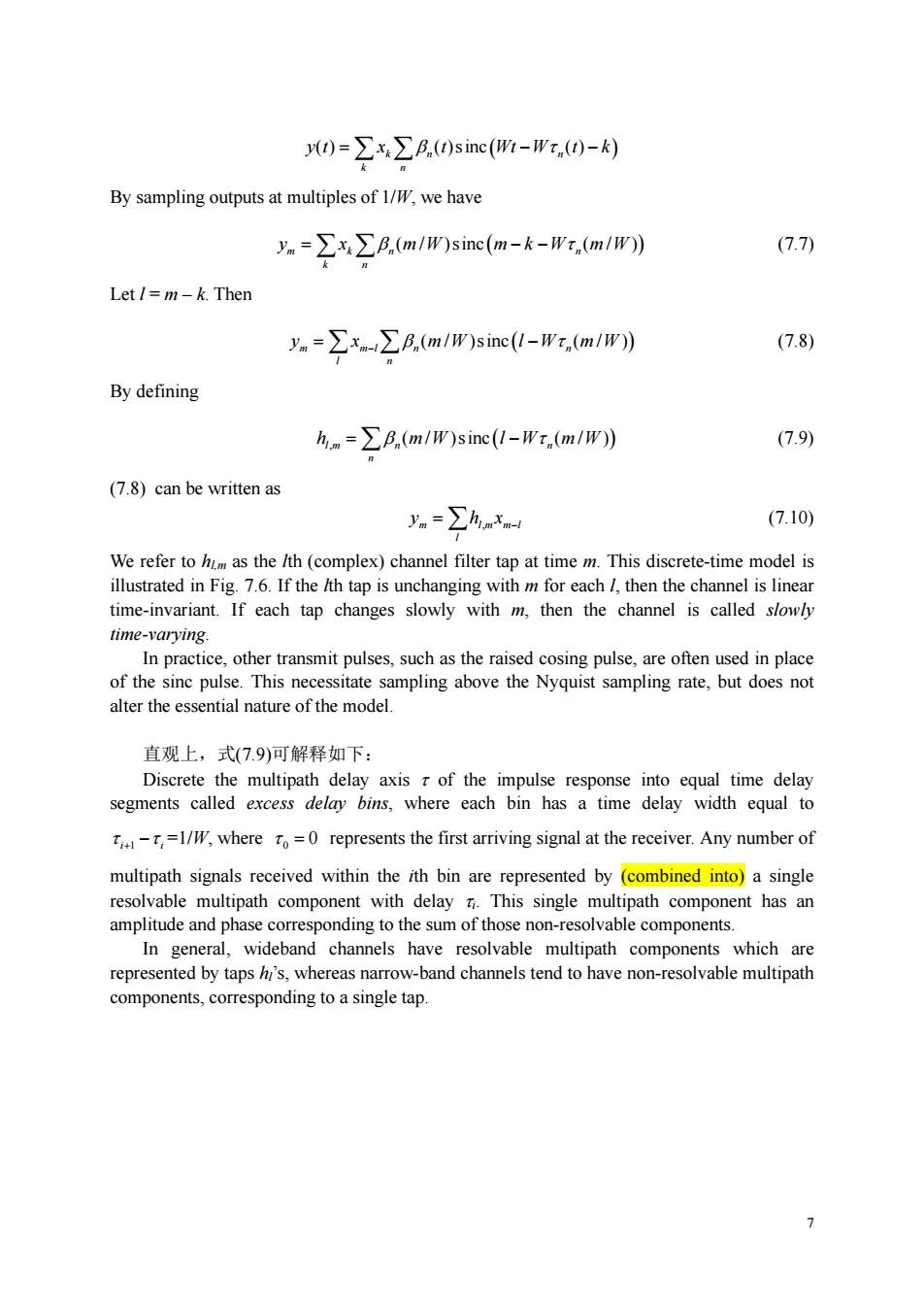
0=∑x∑B.(0sinc(W1-Wx()-k) By sampling outputs at multiples of 1/W,we have y=∑x∑B(m/W)sinc(m-k-Wx.(m/W) (7.7) Let/=m-k.Then y.=∑x-∑B,(m/W)sinc(-Wr,(m/W) (7.8) By defining h=B.(m/W)sinc(1-Wi(m/W)) (7.9) (7.8)can be written as yn=∑hnx (7.10) We refer tohm as the /th(complex)channel filter tap at time m.This discrete-time model is illustrated in Fig.7.6.If the th tap is unchanging with m for each /then the channel is linear time-invariant.If each tap changes slowly with m,then the channel is called slowly time-varying. In practice.other transmit pulses.such as the raised cosing pulse.are often used in place of the sinc pulse.This ne ate mpling above the Nyquist sampling rate,but does not alter the essential nature of the model. 直观上,式(7.9)可解释如下: Discrete the multipath delay axis r of the impulse response into equal time delay segments called excess delay bins,where each b in has a time delay width equal to ,=1/,where0represents the first arriving signal at the receiver.Any number of multipath signals received within the ith bin are represented by (combined into)a single resolvable multipath component with delay This single multipath component has an amplitude and phase corresponding to the sum of those non-resolvable components. In ge eral. widehand channels esolvable multipath components whichr represented by taps h's,whereas narrow-band channels tend to have non-resolvable multipath components,corresponding to a single tap. 7
7 ( ) ( )sinc ( ) kn n k n y t x t Wt W t k By sampling outputs at multiples of 1/W, we have m kn n ( / )sinc ( / ) k n y x mW m k W mW (7.7) Let l = m – k. Then m ml n n ( / )sinc ( / ) l n y x mW l W mW (7.8) By defining , ( / )sinc ( / ) lm n n n h mW l W mW (7.9) (7.8) can be written as m lm m l , l y h x (7.10) We refer to hl,m as the lth (complex) channel filter tap at time m. This discrete-time model is illustrated in Fig. 7.6. If the lth tap is unchanging with m for each l, then the channel is linear time-invariant. If each tap changes slowly with m, then the channel is called slowly time-varying. In practice, other transmit pulses, such as the raised cosing pulse, are often used in place of the sinc pulse. This necessitate sampling above the Nyquist sampling rate, but does not alter the essential nature of the model. 直观上,式(7.9)可解释如下: Discrete the multipath delay axis of the impulse response into equal time delay segments called excess delay bins, where each bin has a time delay width equal to i i 1 =1/W, where 0 0 represents the first arriving signal at the receiver. Any number of multipath signals received within the ith bin are represented by (combined into) a single resolvable multipath component with delay i. This single multipath component has an amplitude and phase corresponding to the sum of those non-resolvable components. In general, wideband channels have resolvable multipath components which are represented by taps hl’s, whereas narrow-band channels tend to have non-resolvable multipath components, corresponding to a single tap
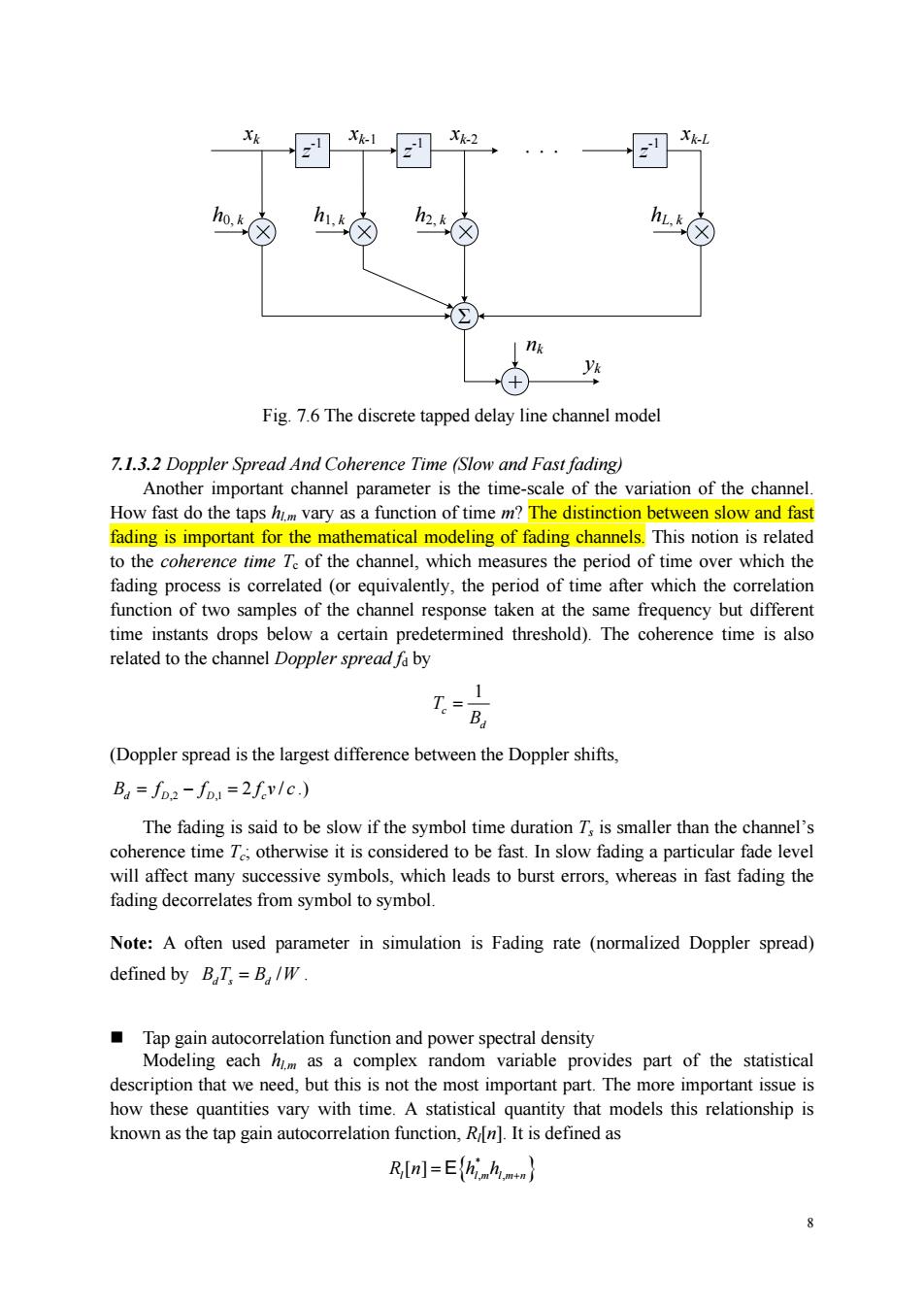
ho.k交 h⊙ ② Fig.7.6The discrete tapped delay line channel model 7.1.3.2 Doppler Spread And Coherence Time(Slow and Fast fading) Another important channel parameter is the time-scale of the variation of the channel How fast do the tapshm vary as a function of time m?The distinction between slow and fast fading is mportant for the mather modeling of fading channels.This notion is related to the coherence rime Tof the channel,which measures the period of time over which the fading process is correlated (or equivalently,the period of time after which the correlation function of two samples of the channel response taken at the same frequency but different time instants drops below a certain predetermined threshold).The coherence time is also related to the channel Doppler spread faby T.Ba (Doppler spread is the largest difference between the Doppler shifts, B,=f2-f1=2fv/c.) The fading is said to be slow if the symbol time duration T,is smaller than the channel's coherence time Totherwise it is considered to be fast.In slow fading a particular fade level will affect many successive symbols,which leads to burst errors,whereas in fast fading the fading decorrelates from symbol to symbol. Note:A often used parameter in simulation is Fading rate (normalized Doppler spread) defined by BT,=B/W. orrelation function and power spectral description that we need,but this is not the most important part.The more important issue is how these quantities vary with time.A statistical quantity that models this relationship is known as the tap gain autocorrelation function,R.It is defined as RL川=Ehhn}
8 z -1 z -1 z -1 × × × × Σ xk xk-1 xk-2 xk-L nk yk h0, k h1, k h2, k hL, k . . . Fig. 7.6 The discrete tapped delay line channel model 7.1.3.2 Doppler Spread And Coherence Time (Slow and Fast fading) Another important channel parameter is the time-scale of the variation of the channel. How fast do the taps hl,m vary as a function of time m? The distinction between slow and fast fading is important for the mathematical modeling of fading channels. This notion is related to the coherence time Tc of the channel, which measures the period of time over which the fading process is correlated (or equivalently, the period of time after which the correlation function of two samples of the channel response taken at the same frequency but different time instants drops below a certain predetermined threshold). The coherence time is also related to the channel Doppler spread fd by 1 c d T B (Doppler spread is the largest difference between the Doppler shifts, ,2 ,1 2 / BdD D c f f fv c .) The fading is said to be slow if the symbol time duration Ts is smaller than the channel’s coherence time Tc; otherwise it is considered to be fast. In slow fading a particular fade level will affect many successive symbols, which leads to burst errors, whereas in fast fading the fading decorrelates from symbol to symbol. Note: A often used parameter in simulation is Fading rate (normalized Doppler spread) defined by / Bds d T BW . Tap gain autocorrelation function and power spectral density Modeling each hl,m as a complex random variable provides part of the statistical description that we need, but this is not the most important part. The more important issue is how these quantities vary with time. A statistical quantity that models this relationship is known as the tap gain autocorrelation function, Rl[n]. It is defined as * , , [ ] Rn h h l lm lm n E
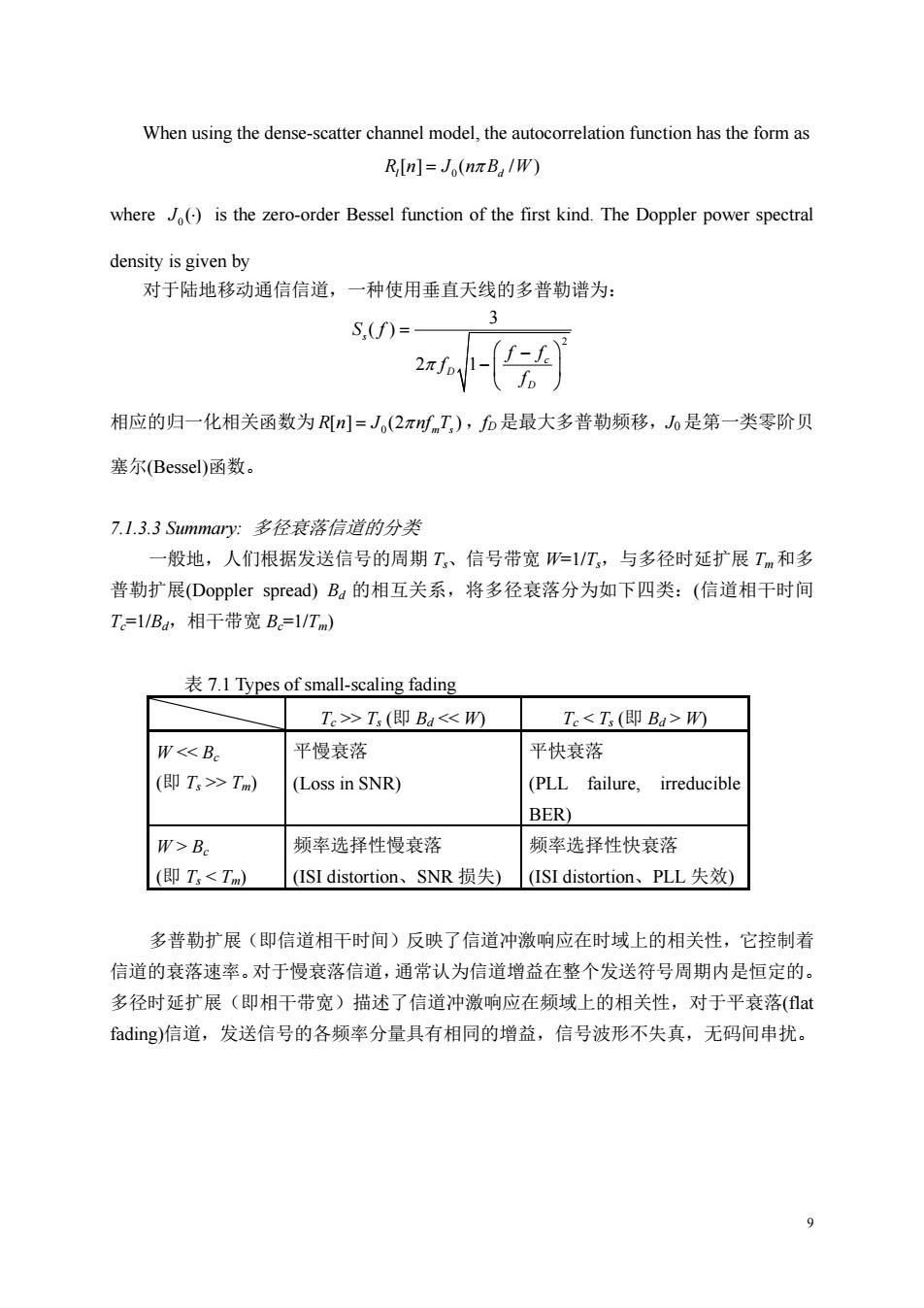
When using the dense-scatter channel model,the autocorrelation function has the form as RLm=J(nrB。/W) where)is the zero-order Bessel function of the first kind.The Doppler power spectral density is given by 对于陆地移动通信信道,一种使用垂直天线的多普勒谱为: S,(f)= 3 f-2 2xfoy-o) 相应的归一化相关函数为n=J。(2πT,),D是最大多普勒频移,6是第一类零阶贝 塞尔(Bessel)函数。 7.1.3.3 Summary:多径衰落信道的分类 一般地,人们根据发送信号的周期T,、信号带宽W=1/T,与多径时延扩展Tm和多 普勒扩展(Doppler spread)Ba的相互关系,将多径衰落分为如下四类:(信道相干时间 T=1/Ba,相干带宽B。=l/Tm) 7.1 Types of small-scaling fading Te>T(即Ba WTm) Loss in SNR) (PLL failure,irreducibl BER) W>B. 频率选择性慢衰落 频率选择性快衰落 (即T,<Tm) (ISI distortion、SNR损失)(ISI distortion、PLL失效) 多普勒扩展(即信道相干时间)反映了信道冲激响应在时域上的相关性,它控制着 信道的衰落速率。对于慢衰落信道,通常认为信道增益在整个发送符号周期内是恒定的。 多径时延扩展(即相干带宽)描述了信道冲激响应在频域上的相关性,对于平衰落(lt fading)信道,发送信号的各频率分量具有相同的增益,信号波形不失真,无码间串扰
9 When using the dense-scatter channel model, the autocorrelation function has the form as 0 [] ( / ) Rl d n J nB W where 0 J ( ) is the zero-order Bessel function of the first kind. The Doppler power spectral density is given by 对于陆地移动通信信道,一种使用垂直天线的多普勒谱为: 2 3 ( ) 2 1 s c D D S f f f f f 相应的归一化相关函数为 0 [ ] (2 ) R m s n J nf T ,fD是最大多普勒频移,J0 是第一类零阶贝 塞尔(Bessel)函数。 7.1.3.3 Summary: 多径衰落信道的分类 一般地,人们根据发送信号的周期 Ts、信号带宽 W=1/Ts,与多径时延扩展 Tm和多 普勒扩展(Doppler spread) Bd 的相互关系,将多径衰落分为如下四类:(信道相干时间 Tc=1/Bd,相干带宽 Bc=1/Tm) 表 7.1 Types of small-scaling fading Tc >> Ts (即 Bd W) W > Tm) 平慢衰落 (Loss in SNR) 平快衰落 (PLL failure, irreducible BER) W > Bc (即 Ts < Tm) 频率选择性慢衰落 (ISI distortion、SNR 损失) 频率选择性快衰落 (ISI distortion、PLL 失效) 多普勒扩展(即信道相干时间)反映了信道冲激响应在时域上的相关性,它控制着 信道的衰落速率。对于慢衰落信道,通常认为信道增益在整个发送符号周期内是恒定的。 多径时延扩展(即相干带宽)描述了信道冲激响应在频域上的相关性,对于平衰落(flat fading)信道,发送信号的各频率分量具有相同的增益,信号波形不失真,无码间串扰
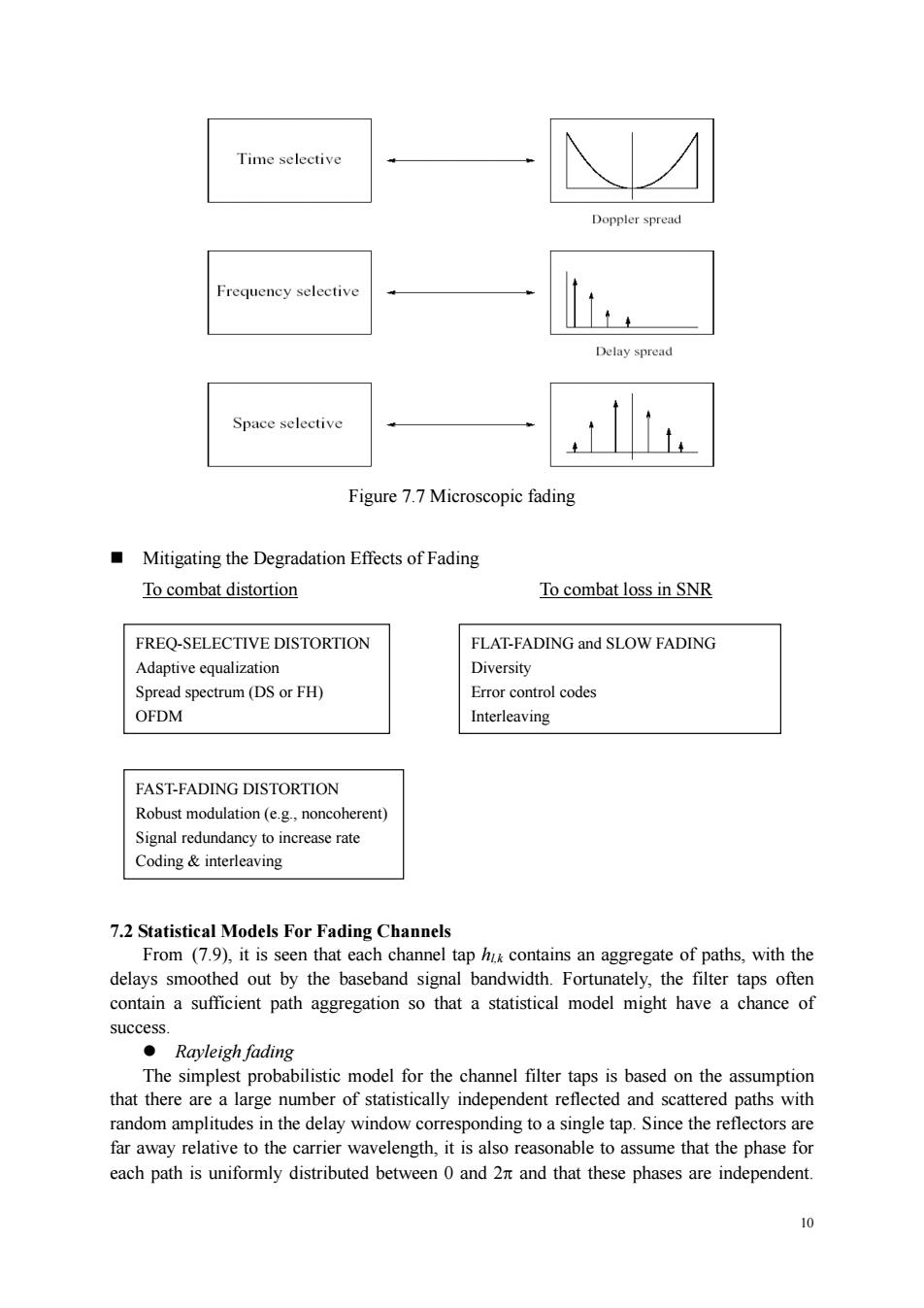
Time selectiv Doppler sprea Frequency selective Delay spread Space selective Figure 7.7 Microscopic fading Mitigating the Degradation Effects of Fading To combat distortion To combat loss in SNR FREO-SELECTIVE DISTORTION FLAT-FADING and SLOW FADING Adaptive equalization Diversity ead spectrum(DS or FH) Error control codes OFDM Interleaving FAST-FADING DISTORTION Signal undancy to ncrease rat 7.2 Statistical Models For Fading Channels From (7.9),it is seen that each channel tap h contains an aggregate of paths,with the delays smoothed out by the baseband signal bandwidth.Fortunately,the filter taps often contain a sufficient path aggregation so that a statistical model might have a chance of ●Rayleigh fading The simplest probabilistic model for the channel filter taps is based on the assumption that there are a large number of statistically independent reflected and scattered paths with oapntudes in the delay window corresponding to a single tap.Since the renec far away relative to the carrie onable to ass ume that the phase for each path is uniformly distributed between 0 and 2 and that these phases are independent
10 Figure 7.7 Microscopic fading Mitigating the Degradation Effects of Fading To combat distortion To combat loss in SNR 7.2 Statistical Models For Fading Channels From (7.9), it is seen that each channel tap hl,k contains an aggregate of paths, with the delays smoothed out by the baseband signal bandwidth. Fortunately, the filter taps often contain a sufficient path aggregation so that a statistical model might have a chance of success. Rayleigh fading The simplest probabilistic model for the channel filter taps is based on the assumption that there are a large number of statistically independent reflected and scattered paths with random amplitudes in the delay window corresponding to a single tap. Since the reflectors are far away relative to the carrier wavelength, it is also reasonable to assume that the phase for each path is uniformly distributed between 0 and 2 and that these phases are independent. FREQ-SELECTIVE DISTORTION Adaptive equalization Spread spectrum (DS or FH) OFDM FLAT-FADING and SLOW FADING Diversity Error control codes Interleaving FAST-FADING DISTORTION Robust modulation (e.g., noncoherent) Signal redundancy to increase rate Coding & interleaving